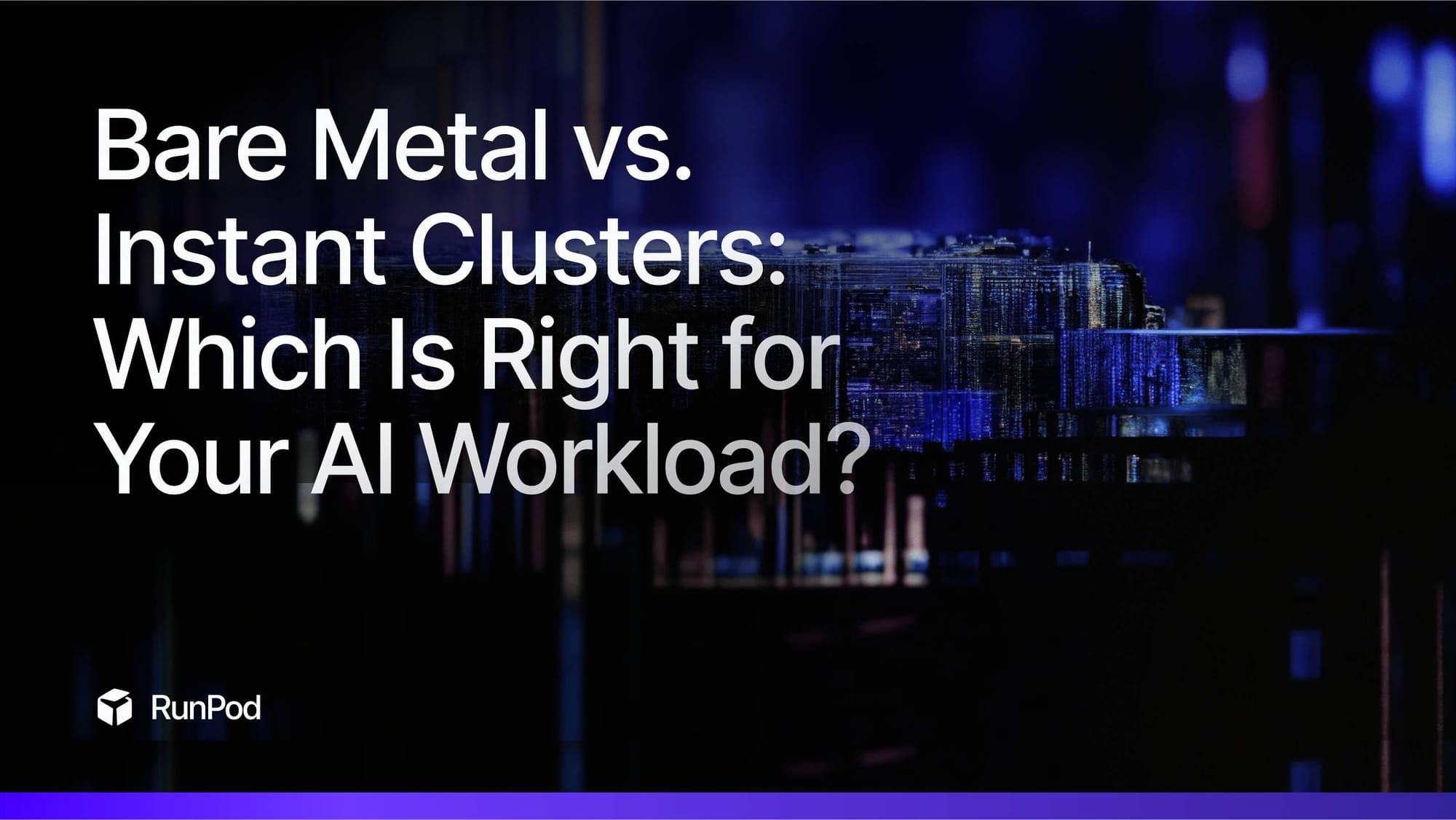Bare Metal vs. Instant Clusters: Which Is Right for Your AI Workload?
Instant Clusters are here. RunPod’s newest deployment option lets you spin up multi-node environments in minutes—no contracts, no config files. Learn how they compare to Bare Metal and when to use each for your AI workloads.

If you're building AI at scale, you've probably felt the pain of infrastructure decisions. The GPU you need is out of stock. Your cloud bill looks like a phone number. Or maybe you're knee-deep in networking configs when you just want to run your model.
Good news: RunPod just launched Instant Clusters, adding a powerful new deployment option alongside our Bare Metal offerings. RunPod gives you multiple ways to run AI workloads—from flexible Pods and Serverless endpoints to Bare Metal and now, Instant Clusters for when you need serious scale.
Let’s break it down.
What's the Difference?
Bare Metal gives you full access to a physical server: no hypervisors, no container layers—just raw hardware you can control top to bottom. It’s ideal for long-term, stable workloads where you need system-level access and don’t mind doing some setup.
Instant Clusters give you the flexibility of on-demand compute with the ability to spin up multi-node environments quickly—similar to Bare Metal, but containerized. They’re great for scaling fast, but they don’t support lower-level orchestration tools like Kubernetes. Think: plug-and-play clusters that support inter-node communication but not full system-level customization.
Spin up multi-node deployments in minutes, powered by Docker and high-speed networking—with support for hundreds of GPUs as we expand capacity. It’s the fastest way to go big without signing your life away.
When to Use Bare Metal
If you need full control over the environment—including OS, drivers, and kernel modules—Bare Metal is a great fit. It shines when your workload runs for days or weeks at a time, doesn’t require scaling across multiple nodes, and benefits from consistent, predictable performance. Think: stable model training, infrastructure experimentation, or anything low-level that Docker containers can’t quite accommodate.
When to Use On-Demand Clusters
Clusters are purpose-built for VRAM-intensive, fast-moving workloads. If your model needs more than 8 GPUs, or you're working with something massive like DeepSeek R1 or LLaMA 405B, Clusters unlock those use cases. They're also a great fit for simulations, parameter sweeps, and experiments where you want to scale up, get results, and shut things down—all without touching a config file.
The bottom line? If you want to scale big and scale fast, without a long-term contract or setup overhead, Clusters are the move.
| Feature | Bare Metal | Instant Clusters |
|---|---|---|
| GPU Types | H100, A100, etc. | H100 (initially) |
| Billing | Monthly or committed terms | Pay-per-second |
| Setup Time | Hours to days | Minutes |
| Multi-node Support | Manual setup required | Built-in |
| System Access | Full | Docker container |
| Best For | Control, customization | Flexibility, scale |
Why Instant Clusters Change the Game
Historically, RunPod users were generally limited to 8 GPUs per pod—essentially one server. That worked for most use cases, but it capped your ceiling if you needed to do something bigger. With Clusters, that ceiling’s gone. You can now connect dozens of GPUs across multiple nodes with high-speed networking, giving you access to a whole new tier of performance.
Want to train a foundation model from scratch or fine-tune something huge? Need to run a massive simulation in hours instead of weeks? This is how.
And because Clusters launch in minutes and bill by the second, you’re not locked into multi-month commitments or stuck paying for idle time.
The Old Way: Long-Term Cluster Contracts
With traditional bare metal providers, you usually get an SSH key and a 12-month contract. You wait days for provisioning, spend hours configuring nodes, and start paying before your job even runs. It’s painful, it’s expensive, and it doesn’t scale well.
RunPod’s approach skips all of that.
Why Not Both?
You don’t have to choose one forever. Use Bare Metal for stable jobs or environments where you need complete control. Use Clusters when you need to scale up fast, run something huge, or move quickly. Both are available under the same UI, with shared billing, storage, and monitoring.
TL;DR
Bare Metal is for the control freaks (no shame). You want to touch the kernel, choose your drivers, and know exactly what’s running under the hood? Go for it.
Instant Clusters are for people who don’t have time to argue with infrastructure. You’ve got 30 billion parameters to fine-tune, and deadlines that don’t care about provisioning delays.
And if you're the kind of person who wants both? Same. That’s why we built both.
Ready to Spin Up?
RunPod now gives you full flexibility across compute models. Bare Metal for control, Instant Clusters for instant scale. Pick what fits your workflow—and switch it up as your needs evolve.
Launch your On-Demand Clusters or explore Bare Metal to get started.
Got thoughts? Feedback? Use cases you want to share? I’d love to hear from you.
